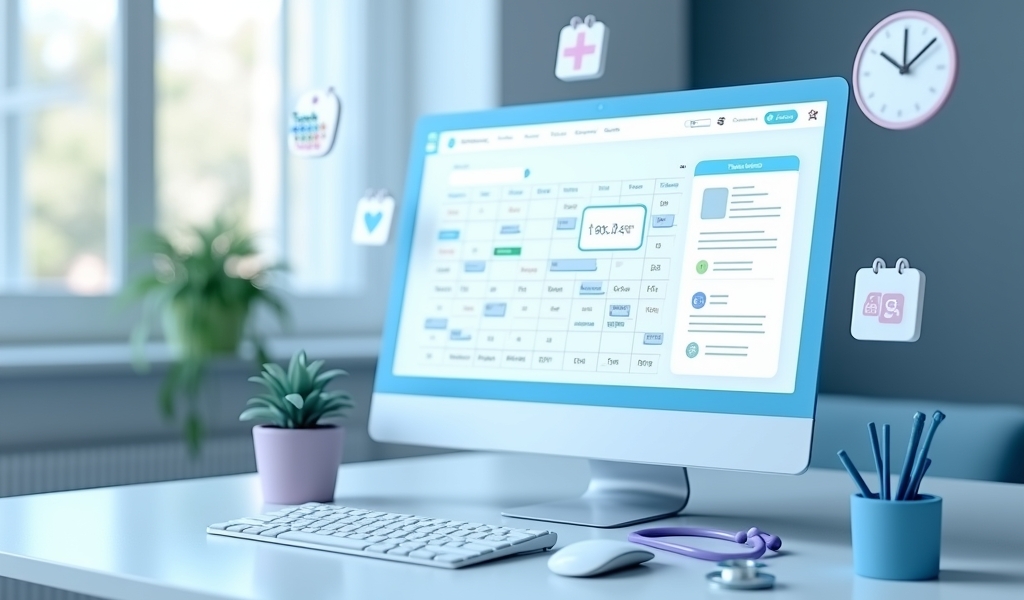Overview
Online doctor appointment scheduling has become the preferred method for 68% of patients, offering 24/7 booking convenience while eliminating phone holds and reducing no-show rates by 17%. The five-step process involves finding your provider’s portal, creating/accessing your account, selecting the right appointment type, choosing a preferred time slot, and completing pre-visit tasks – all contributing to a streamlined healthcare experience that benefits both patients and providers.
Table of Contents
- Why Online Appointments Are Becoming the Norm
- Step 1: Find Your Healthcare Provider’s Online Portal
- Step 2: Create or Access Your Patient Account
- Step 3: Select the Right Appointment Type
- Step 4: Choose Your Preferred Date and Time
- Step 5: Confirm Your Appointment and Complete Pre-Visit Tasks
- Troubleshooting Common Issues
- The Future of Healthcare Scheduling Is Digital
- Frequently Asked Questions
In today’s fast-paced world, the healthcare industry is embracing digital transformation to improve patient experiences. One significant advancement is the ability to schedule medical appointments online, eliminating long phone holds and offering 24/7 booking convenience. At Dr. Telx, we’ve seen firsthand how online doctor scheduling systems have revolutionized the way patients access care. This guide will walk you through five simple steps to easily book your next doctor’s appointment online, saving you time and reducing the stress often associated with healthcare coordination.
Why Online Appointments Are Becoming the Norm
The shift toward digital scheduling has accelerated dramatically in recent years. According to a 2023 healthcare consumer survey, over 68% of patients now prefer online booking options when available. This trend isn’t surprising when you consider the benefits: patients can book appointments anytime (even outside office hours), compare available times at a glance, and receive instant confirmation.
For healthcare providers, online scheduling reduces administrative burdens, decreases no-show rates by 17% on average, and improves overall practice efficiency. The COVID-19 pandemic significantly accelerated this digital transition, with patient portal usage increasing by 50% between 2020 and 2023 as people sought contactless healthcare solutions.
Making a doctor’s appointment online has become increasingly popular as nearly 90% of hospitals now offer patient portal capabilities. These digital tools not only streamline the booking process but also improve healthcare access for patients with mobility issues or those living in rural areas.

Step 1: Find Your Healthcare Provider’s Online Portal
The first step in booking an online appointment is locating your provider’s scheduling system. Most healthcare practices prominently feature booking buttons on their websites—typically labeled “Schedule Appointment,” “Book Now,” or “Patient Portal.” If you’re a Dr. Telx patient, you’ll find our scheduling button prominently displayed in the top navigation bar of our website.
For established patients, check your email inbox for messages from your provider containing direct links to their scheduling platform. Many medical practices also use specialized healthcare apps that allow appointment booking, prescription refills, and secure messaging with your provider.
If you can’t find direct online booking, don’t give up—call the office and ask if they offer digital scheduling options. Some practices use third-party platforms like Zocdoc, Healthgrades, or even their Electronic Medical Record’s patient portal for scheduling.
When searching for a new provider, consider practices that offer same-day appointment availability through their online systems. Many modern healthcare facilities now reserve slots specifically for urgent care needs that can be booked digitally.
Step 2: Create or Access Your Patient Account
Once you’ve located the scheduling platform, you’ll need to access your patient account. If you’re a new patient, prepare to enter basic personal information, including:
- Full legal name
- Date of birth
- Contact information (email and phone)
- Address
- Insurance details (have your card handy)
- Emergency contact
Existing patients simply need to log in with their username and password. If you’ve forgotten your login credentials, most systems offer password recovery options through the email address on file. For security reasons, medical portals typically have stricter password requirements and may lock accounts after multiple failed login attempts.
Make sure your contact information remains current in your profile to receive important appointment confirmations and reminders. Many platforms now offer two-factor authentication for additional security, which we highly recommend enabling to protect your sensitive medical information.
Step 3: Select the Right Appointment Type
After logging in, you’ll need to select the appropriate appointment type from the available options. Medical practices typically categorize appointments based on the nature of care needed:
- Annual physical/wellness exam
- Follow-up appointment
- Sick visit/acute care
- Specialist consultation
- Procedure-specific appointments
- Telehealth/virtual visits
Be as specific as possible when selecting your appointment type and describing your symptoms or concerns. This information helps providers allocate the appropriate amount of time and prepare for your visit. If you’re experiencing symptoms that could indicate a medical emergency (severe chest pain, difficulty breathing, signs of stroke), don’t wait for an online appointment—seek emergency care immediately.
Virtual doctor appointments have become increasingly popular for issues like minor illnesses, medication management, and certain follow-up appointments. When deciding between virtual and in-person care, consider whether your concern requires physical examination or testing that can only be performed in-office.
According to the Centers for Disease Control and Prevention, telemedicine usage has stabilized at levels 38 times higher than pre-pandemic baselines, making it an essential option in modern healthcare delivery.
Step 4: Choose Your Preferred Date and Time
After selecting the appointment type, you’ll see available time slots on a calendar interface. Some helpful strategies for finding convenient appointments include:
- Checking for early morning or late afternoon slots if you work traditional hours
- Looking for cancellations by checking availability a few days before your desired appointment
- Being flexible with providers if you need urgent care (seeing any available doctor rather than waiting for a specific one)
- Considering different office locations if your provider practices at multiple sites
Pay attention to the appointment duration listed, which typically ranges from 15 minutes for simple follow-ups to 60 minutes for comprehensive physicals. If you anticipate needing more time to discuss multiple concerns, some systems allow you to indicate this during booking or in the notes section.
If your preferred time isn’t available, many platforms offer waitlist options that notify you when cancellations occur. Alternatively, consider booking further in advance—many primary care providers’ schedules fill 2-4 weeks ahead for routine appointments.

Step 5: Confirm Your Appointment and Complete Pre-Visit Tasks
After selecting your time slot, carefully review all details before confirming your appointment. Most systems will send an immediate confirmation via email or text, which you should save or add to your personal calendar. Many platforms also allow you to set up reminder notifications (typically 24-48 hours before your appointment).
Following confirmation, you may be prompted to complete important pre-visit tasks:
- Update insurance information
- Complete health history questionnaires
- Upload relevant documents or previous medical records
- Read and sign consent forms
- Verify demographic information
Completing these tasks ahead of time streamlines your in-office experience and gives your provider more time to focus on your care rather than paperwork. Some practices offer arrival time recommendations based on whether you’ve completed pre-registration tasks.
Troubleshooting Common Issues
Even the best online systems occasionally encounter challenges. If you experience technical difficulties, try:
- Using a different web browser or clearing your cache
- Switching from mobile to desktop (or vice versa)
- Checking that your internet connection is stable
- Trying again during non-peak hours
For urgent medical needs that aren’t emergencies but require same-day attention, many practices reserve a limited number of urgent care slots not visible through the online system. In these cases, calling the office directly is often the best approach.
If you need to reschedule, most platforms allow modifications up to 24-48 hours before your appointment without penalty. Changes made closer to your appointment time may incur cancellation fees depending on your provider’s policies.
The Future of Healthcare Scheduling Is Digital
Online appointment scheduling represents just one aspect of healthcare’s digital evolution. At Dr. Telx, we’re committed to embracing technology that enhances the patient experience while maintaining the personal connection that’s essential to quality care.
By following these five simple steps, you can take advantage of the convenience, flexibility, and efficiency of making a doctor’s appointment online. The process not only saves you time but also gives you greater control over your healthcare journey. If you haven’t tried booking an appointment online yet, we encourage you to experience the benefits firsthand during your next healthcare need.
As we look ahead, innovations like AI-powered scheduling assistants, predictive availability, and seamless integration between healthcare systems promise to make accessing care even more convenient. By embracing these digital tools today, you’ll be well-positioned to benefit from the increasingly connected healthcare ecosystem of tomorrow.
Research from the Medical Group Management Association confirms that practices offering online scheduling see increased patient satisfaction scores and improved operational efficiency, creating a win-win scenario for both patients and providers.
Frequently Asked Questions
Is making a doctor’s appointment online secure?
Yes, reputable healthcare providers use secure, HIPAA-compliant systems for online scheduling. These platforms employ encryption, secure servers, and strict access controls to protect your personal health information. For added security, use strong passwords, enable two-factor authentication when available, and always log out when finished using a shared device.
What if I need to see a doctor urgently but don’t see any available appointments online?
If you have an urgent medical need and don’t see available appointments online, call the practice directly. Many providers reserve same-day appointments that aren’t visible in the online system or can offer alternatives like telehealth visits. For true medical emergencies (difficulty breathing, severe pain, etc.), go to the nearest emergency room or call 911.
Can I make appointments for my family members through my online account?
Many healthcare systems allow you to add family members to your account as dependents, especially for minor children. This feature typically requires verification of your relationship and may involve signing consent forms. Some platforms also offer proxy access for adult dependents who need assistance managing their healthcare, though this usually requires additional documentation to comply with privacy regulations.
Are online appointments treated differently than those made by phone?
Appointments made online receive the same level of care as those scheduled through traditional methods. The only difference is the booking mechanism. In fact, many providers appreciate online scheduling because it includes more detailed information about your concerns, allowing them to better prepare for your visit. Some studies suggest patients who book online are also less likely to miss appointments due to the automatic reminders these systems provide.
What information should I have ready before making an online appointment?
Before scheduling online, have your insurance card, a list of current medications, basic medical history, and a clear understanding of your symptoms or reason for visit. If you’re a new patient, you’ll also need your complete contact information and emergency contact details. Taking a few minutes to gather this information beforehand will streamline the scheduling process and ensure your appointment is properly categorized.

